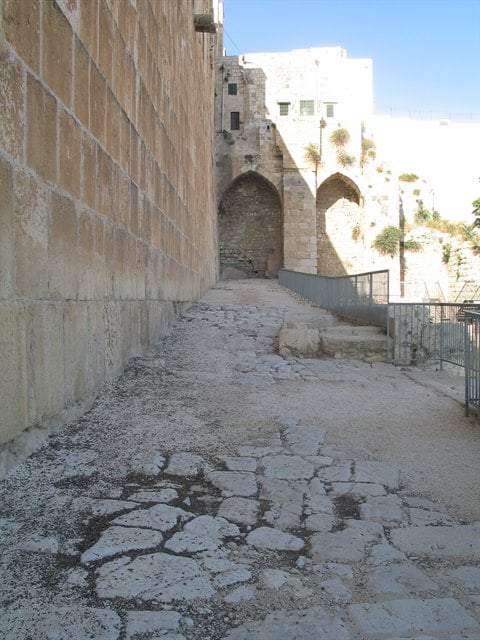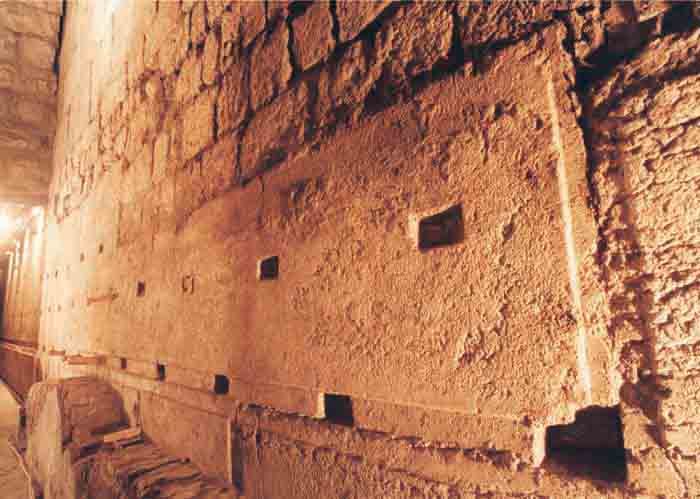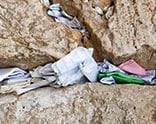- westen wall
- Pages
- What is The Western Wall in jerusalem?
About
What is The Western Wall in jerusalem?
Measurements of the Western Wall (wailing wall)
The Western Wall (wailing wall) is 488 meters long.
Height
In the past, the Western Wall rose to a height of 60 meters. Today, the highest point in the exposed section reaches a height of 40 meters above the bedrock of the eastern hill of Jerusalem (Mt. Moriah).
The section of the Western Wall (wailing wall) that is visible at the Prayer Plaza is comprised of 46 layers of stone. Twenty nine of these layers are exposed above ground and contain stones from different time periods. The remaining seventeen layers are subterranean. This above-ground section reaches a height of 19 meters. However, the height of this section from its foundation to its peak is estimated at approximately 32 meters.

The Western Wall Plaza

The Courses (Stone Rows) of the Western Wall

The Western Wall Stones
The Western Wall sections that are exposed above ground – at the Western Wall Plaza, the Southern Excavations, and in the Muslim Quarter – contain stones from different time periods. They teach us about the various changes that occurred to the Western Wall since the destruction of the Second Temple. The subterranean layers (as well as some of those above ground) are made up of the original Western Wall (wailing wall) stones from the end of the Second Temple period.
Other stones (some of which were in use during the Second Temple period) were placed on top of the layers by Muslims, during different periods of time. The smaller stones at the top of the wailing wall were placed there during the beginning of the 20th century. The original stones can be distinguished from the others based on their size and masonry. The Herodian stones (from the Second Temple period) are characterized by drafted margins etched around their borders.

Ancient Gates
The Western Wall
The Western Wall is one of the four supporting walls of the Temple Mount that remained intact after the destruction of the Second Beit HaMikdash-The Second Temple. It is the wall that faces westward, and it is the closest in proximity to the site of the Holy of Holies, the most sacred location in the Temple for the Jewish people.
Since the Temples’ destruction, the Western Wall has served as a source of inspiration, and the focus of yearning and prayer for the Jewish people throughout many generations. It has helped keep the memory of the Temple alive, and is now a heritage site and location for formal ceremonies of the State of Israel.
The tradition of visiting the Western Wall, touring the length of it and praying next to its gates is an ancient tradition, centuries old. “We have no comfort other than circling the gates and bowing and asking for mercy” – from a letter sent to the Diaspora by the heads of the Jerusalem community, end of the 10th century

Exposed Areas
In addition to the Western Wall Plaza, there are two other exposed segments of the wall: The Southern Section of the Western Wall, and the Small Western Wall (also known as HaKotel HaKatan) which is located in the Muslim quarter.

The Southern Section of the Western Wall
The Western Wall is a retaining wall of the Temple Mount compound. During the Second Temple period, a commercial street ran alongside it, featuring stores that offered goods to the many pilgrims who made the trip to the Temple. During excavations conducted by Professor Benjamin Mazar (between 1968-1978), the southern section of the street was revealed under a pile of shattered Western Wall stones. Amid the Temple’s destruction, Roman soldiers had hurled these stones from the top of the Temple Mount down onto the street, causing damage to the pavestones beneath. This is visible today. One can also see in the area of Robinson’s Arch, that at its time of use the street’s width reached 8.5 meters.

The Small Western Wall (HaKotel HaKatan)
The Small Western Wall is the name of the additional exposed section of the Western Wall located approximately 170 meters north of the Prayer Plaza. It is reached via a narrow alleyway near the Iron Gate, located in the Muslim Quarter. In the past, Jerusalem’s elders would come to the Small Western Wall (wailing wall) for midnight prayer services (Tikkun Chatzot). Ever since the Six Day War, groups of tourists have visited this site and on Friday evenings, Jews come to the praying wall to pray the Shabbat evening prayer service.
The total length of the Small Western Wall (from the entrance gate at the south, until the supporting arch of a Mamluk era building, to the north) is 17.7 meters. The width of the plaza in front of it is 4.2 meters. The wall contains stones from different time periods, with the largest of them measuring 1.15 meters in length.
In 1971, during the restoration of its northern arch by the Office for Religious Affairs, some of the Small Western Wall’s stones were accidentally damaged. The rabbi of the Western Wall at the time, Rabbi Meir Yehuda Getz (of blessed memory), gathered the stone shards with great reverence and exhibited them at the Western Wall Plaza.

The Great Course (Nidbach Raba)
The Great Course is the name given to a layer of huge stones from the days of Herod the Great, which can be seen from the Great Hall in the Western Wall tunnels. This course of stones is the tallest and longest in the Western Wall and its stones are the largest building stones found in Israel. The first stone towards the south of the Great Course is its largest: it is 13.55 meters long, its width is estimated at between 2.00 and 4.6 meters, and it is 3.3 meters in height. Its weight is estimated at several hundred tons. The length of the second stone is 2.0 meters, the third is 12.12 meters and the fourth is 8 meters long.

Robinson’s Arch
Robinson’s Arch is the arch at the southwest corner of the Temple Mount. In the days of the Second Temple, one of the western gates to the Temple Mount was positioned above it. A stairway led from the gate to the street which descended to the southern part of Jerusalem.
The arch was uncovered in 1838 by a British scholar named Edward Robinson. Robinson’s Arch is referred to in Joseph ben Matityahu’s (Flavius Josephus’) writings: “and the last led to the other city, where the road descended into the valley by a great number of steps, and thence up again” (Flavius Josephus, Antiquities of the Jews).
The total length of Robinson’s Arch is 15.2 meters and its height is approximately 17.5 meters. The width of the arch is 12.90 meters. The arch’s western pillar/supporting wall has a width of 3.60 meters. Under the arch, the width of the street is about 8 meters.
Barclay’s Gate
In 1854, American tourist and researcher, Dr. James Barclay identified the lintel of an entrance gate to the Temple Mount in the southern corner of what is now the womens’ section of the Prayer Plaza. The original gate led down under the area of the Temple Mount, and a stairway led from it up to the Temple Mount plaza. This gate is also mentioned in the writings of Joseph ben Matityahu (Flavius Josephus). There are those who identify it as “Solomon’s Gate” which is mentioned in the list of gates in a specific prayer, one which was customarily recited across from the Temple Mount gates in the beginning of the Muslim period. The prayer and the names of the gates were discovered in the Cairo Geniza, and date to the tenth century.

Wilson’s Arch
Wilson’s Arch is adjacent to the Western Wall. It is the largest of the Great Bridge vaults. Today it serves as the indoor, covered mens’ section of the Prayer Plaza at the Western Wall. The arch was built during the ancient Muslim period, in the same location as a previous narrow arch which stood there during the Second Temple period.The length of the arch is 15 meters and the span is 12.90 meters. Today, the Gate of the Chain is above the arch.

Warren’s Gate
Warren’s Gate, dating back to the end of the Second Temple period, is one of the gates at the Western Wall. Herod the Great paved a road along the Western Wall, and this gate led from the road, toward the Temple Mount. It led to a long, subterranean passageway and from there, up a stairway to the Temple. After the destruction of the Second Temple, the gate was abandoned and during the ancient Muslim period it was used by Jews as a synagogue. The width of the gate is 6 meters and its length is 30 meters.
Entrance Gates to the Temple Mount
Today there are six entrance gates at the Western Wall that lead to the Temple Mount. These gates were built between the early Muslim period and the Ottoman period.
The Mughrabi Gate This is the southernmost gate to the Temple Mount. Its width is 2.2 meters and it reaches a height of 3.8 meters. The gate is named for the Muslim immigrants who settled near the southern section of the Western Wall at the end of the 12th century. They arrived from the lands of northwest Africa, Maghreb (Morocco), and for several generations there was a Mughrabi neighborhood at the site of today’s Prayer Plaza of the Western Wall.
This neighborhood was vacated after the Six Day War.
The Chain Gate This gate has two openings: “Bab as-Silsileh”- Chain Gate located at the south, and “Bab as-Salam”-Tranquility Gate, located towards the north. The Chain Gate dates back to the Mamluk period, but has remnants from earlier Crusader periods. In the Jewish text The Gates Prayer (found in the Cairo Geniza), this gate is identified as David’s Gate. Additionally there are those who identify it as the Gate of the Divine Presence. The road that leads to it is also called Chain Street in Arabic. Some opinions say that the name “chain” was given by Jews in memory of the chain to which the key to the Temple Mount gates was tied, in the days of the Holy Temple.
The Cotton Merchants’ Gate This is a covered market dating from the Mamluk period. It was built at the beginning of the fourteenth century, in the days of the sultan al-Nasir Muhammad ibn Qalawun. In the southwest corner of the Cotton Merchants’ Gate there are remnants of a double bathhouse dating to the beginning of the fourteenth century. Jewish women of the 19th century used them as a mikvah (ritual bath) and they were in continuous use until the 1980’s. Up until WWII, water reached this site via the lower aqueduct of Jerusalem.
During the Crusader period, this gate was called The Beautiful Gate. To the south of the Cotton Merchants’ Gate there is an ancient bathhouse called Hamam Ashaefa (the Healing Bathhouse).
Because the Cotton Merchant’s Gate is the closest gate to the site of the Temple and the Foundation Stone, Jews have traditionally sat near it to mourn the destruction of the Temple throughout the generations.
The Iron GateThis gate dates back to the Mamluk period. To the north of the gate there is a small alleyway that leads to the Small Western Wall (HaKotel HaKatan).
The Council Gate/The Inspector’s Gate This gate is named due to its proximity to the offices of the Waqf, the seat of the High Muslim council. In the Middle Ages it was called Michael’s Gate, named for the angel, Michael. The gate has other names as well, including:
-Bab al Hamas (prison): for the ancient Mamluk-Ottoman prison located at this site
-Bab al Rabat: meaning, “the place of residence of Muslim monks” (apparently in the madrassas-the Muslim learning halls)
In The Gates Prayer, this gate is identified as Bab al Baqar (in Hebrew, Sha’ar HaMashgiach).
The structure of the gate dates from the end of the ancient Muslim period.
The Gate of Bab al-Ghawanima This is the northernmost gate among those along the Western Wall. It can be reached via an alley north of the Ateret Kohanim Yeshiva. The gate is named for a Muslim family who took ownership of it when they resided in the area from the 15th century.






